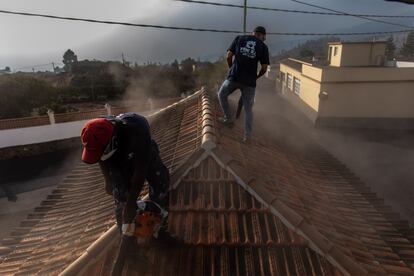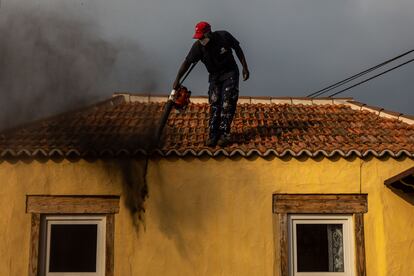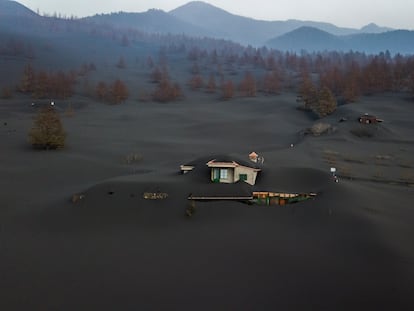How the volcano on La Palma has changed the habits of businesses – from roof cleaning to binocular selling
Residents of the Canary Island explain the effect that the ongoing eruption has had on their work, such as the tour guide whose current mission is to get as close to the lava as possible


Violeta Canabal, 52, has never before hired someone to clean her roof. Federico Brito, 28, has never had to clean roofs to earn a living. The ongoing volcanic eruption on the Canary Island of La Palma has altered the needs of the former, and as a result, has also changed the services offered by the latter.
Canabal’s house, which is located in the municipality of El Paso, is covered with a layer of volcanic sand – just like the rest of the Aridane valley, which is located near to where the new volcano erupted on September 19. “I’ve been up there a few times to clear the ash from the roof, but I end up exhausted,” she explains. “My back is done for. I can’t climb up there again.”
That’s where Brito comes in. He normally works as a gardener, house painter and general odd-job man, but the eruption of the volcano – which shows no sign of letting up all these weeks later – has seen him adapt his daily routines.
“When the volcano started to spew out lava we saw that we had to stop our other work somewhat,” he explains. “Right now everyone is calling us for this, something that we didn’t use to do. Normally no one worries about getting their roof cleaned. We are doing 10 houses a day,” he adds, his grimy face and arms testament to his busy schedule.

A quick look at classified webpages on the island show a number of results from companies specifically offering cleaning services for roofs. Some even say that they will carry out the service in the exclusion zones, areas where evacuated residents can only enter to collect belongings or clean up every once in a while.
Brito’s company, Fede BG, got into the business almost by accident. “Customers who I have a close relationship with asked me to take the ash off their houses, and in particular from the roofs,” he explains. “One of them told a friend, who called me. And then he told his grandma, who also got in touch. So that’s where we are.”
The people who have been enquiring after his services are doing so given their fear that their roof could collapse from the weight of the ash. “If they see on their cellphones that it’s going to rain, they call up in tears,” he says, given that the ash weighs a lot more when wet.
The volcano has changed the routine of Brito and of many other workers. This is not just applicable to professions related to dealing with a natural disaster, such as the emergency services, who are on hand for any incidents; the police, who are tasked with controlling access to the exclusion zones and ensuring road safety; healthcare workers, who are combatting the effects of the crisis on people’s health; and social workers, who are attending to the needs of those who have lost their homes or possessions. There are other jobs where the change in activity is not so obvious from outside, but a considerable shift is there to see once you get into the details.
Julio Marante, 39, has been a tourist guide on the Canary Island for years. During his visits to La Palma, he would always explain about the volcanos – the Spanish archipelago, which is located off the northwestern coast of Africa, is volcanic in origin. “My day-to-day life has radically changed,” he explains. “Before I used to offer routes in a number of areas on the island. Now the tourists come thinking only about the volcano.”
Marante says that this situation is a shame, given that the island is home to laurel forests, grey beaches and hidden bays, and has a history of other eruptions that stretch way back in time. “Tourists just want to go walking to the lava, to get as close as possible,” he explains. “And they want to visit the vantage point at Tajuya church, which has become another protagonist in the interest for the volcano.” In fact, the viewpoint from Tajuya has become the busiest place on the island from which to see the eruption.
This change in the habits of tourists on La Palma has affected Marante’s routines. “For example, I used to work more in the mornings. That’s normal with the big groups that used to come to the island. Now it’s all about the nighttime, which is when you can best see the volcano, and with groups of two or three people. Visitors are not hiding the reasons why they are coming to La Palma.”
He explains that there are more and more independent guides and agencies on the island who are specializing in very specific routes in order to see the volcano from different places.
The lava from the eruption has already swallowed up the homes of more than 2,000 residents and has seen 7,000 more evacuated – that’s nearly 10% of the population of the island who are not collecting their mail from their mailboxes. “Imagine how busy we have been,” says the director of the Correos post office in Los Llanos de Aridane, Sonia Peñalva, 59. “We have been going non-stop for 40 days,” she says. “It’s been crazy, but we’re doing everything we can to help.”
Those who have lost their homes to the molten rock can request mailboxes in the post office where they can get their correspondence, and they can also request mail to be diverted to the addresses where they are currently staying. These services usually have a cost, but in Los Llanos they are being offered for free to those affected by the eruption.
I have never, ever sold as many binoculars as I have right nowAntonio González, technology store owner
“When they come to sort one of these things out they break down,” Peñalva explains. “People are really suffering. The service is very slow because we stop to listen to them and attend to them. All of this has multiplied our workload a great deal.”
She finishes the conversation by referring to the earthquake felt on Wednesday at 7.27am, and which measured 4.9 on the Richter scale. “It happened while I was here, working,” she explains. “Everything shook. And I’m from Burgos [a city in northern Spain]. I could never have imagined that my life was going to be like this.”
Another of the needs of the evacuees is to know with some precision exactly where the lava will be headed. “I have never, ever sold as many binoculars as I have right now,” explains Antonio González, 45, in his technology store in Los Llanos. “The tourists bring them from home. All of the buyers are people from the area concerned about whether the lava flow has reached their homes.” Among these are seniors, “people who you would never imagine buying binoculars but who are completely devastated. What’s more, there are even people who come and explain to you where they are watching from and from what distance, so that they can buy the most-accurate equipment possible. Some are even choosing telescopic sights.”
Another product that has been selling fast lately, and that was practically a decoration in González’s store until the eruption, are clothes driers. “None of them went before – they’re not necessary on an island with so much sun,” he explains. Given the constant ashfall, people can’t hang out their clothes. “When it became clear that the eruption was going to last, they started to buy them. During the first weeks, a lot of mattresses were sold by González in his other business, a furniture store. There are so many people sleeping in the houses of friends and family…”
The changes in the habits of these people do not necessarily mean an improvement in their financial situation. The volcano is hitting them where it hurts, just as it is the rest of the island. Brito is painting fewer houses, Marante is offering fewer tours than before, and the lava swallowed up a warehouse where González had stock worth around €300,000. “I would like to think that we have not lost our backbone, even though this has shifted our feet,” explains the man who is selling binoculars like they were hot cakes.
Tu suscripción se está usando en otro dispositivo
¿Quieres añadir otro usuario a tu suscripción?
Si continúas leyendo en este dispositivo, no se podrá leer en el otro.
FlechaTu suscripción se está usando en otro dispositivo y solo puedes acceder a EL PAÍS desde un dispositivo a la vez.
Si quieres compartir tu cuenta, cambia tu suscripción a la modalidad Premium, así podrás añadir otro usuario. Cada uno accederá con su propia cuenta de email, lo que os permitirá personalizar vuestra experiencia en EL PAÍS.
¿Tienes una suscripción de empresa? Accede aquí para contratar más cuentas.
En el caso de no saber quién está usando tu cuenta, te recomendamos cambiar tu contraseña aquí.
Si decides continuar compartiendo tu cuenta, este mensaje se mostrará en tu dispositivo y en el de la otra persona que está usando tu cuenta de forma indefinida, afectando a tu experiencia de lectura. Puedes consultar aquí los términos y condiciones de la suscripción digital.
More information

La Palma eruption: Life among earthquakes, ashfall and noxious gases

The neverending job of sweeping up the volcanic ash on La Palma
Últimas noticias
Most viewed
- Sinaloa Cartel war is taking its toll on Los Chapitos
- Oona Chaplin: ‘I told James Cameron that I was living in a treehouse and starting a permaculture project with a friend’
- Reinhard Genzel, Nobel laureate in physics: ‘One-minute videos will never give you the truth’
- Why the price of coffee has skyrocketed: from Brazilian plantations to specialty coffee houses
- Silver prices are going crazy: This is what’s fueling the rally








































